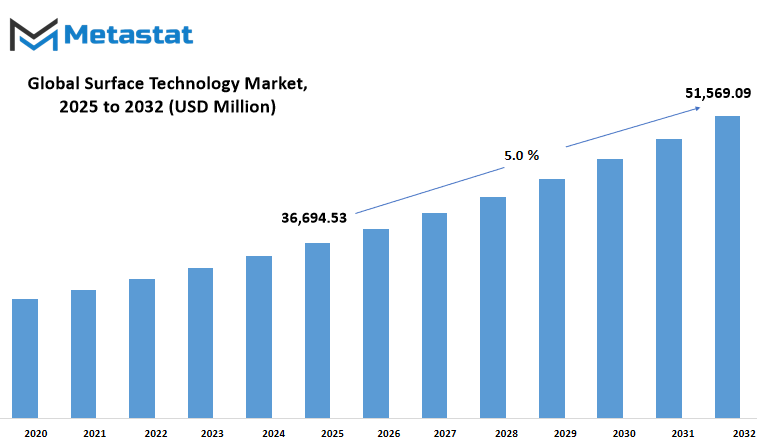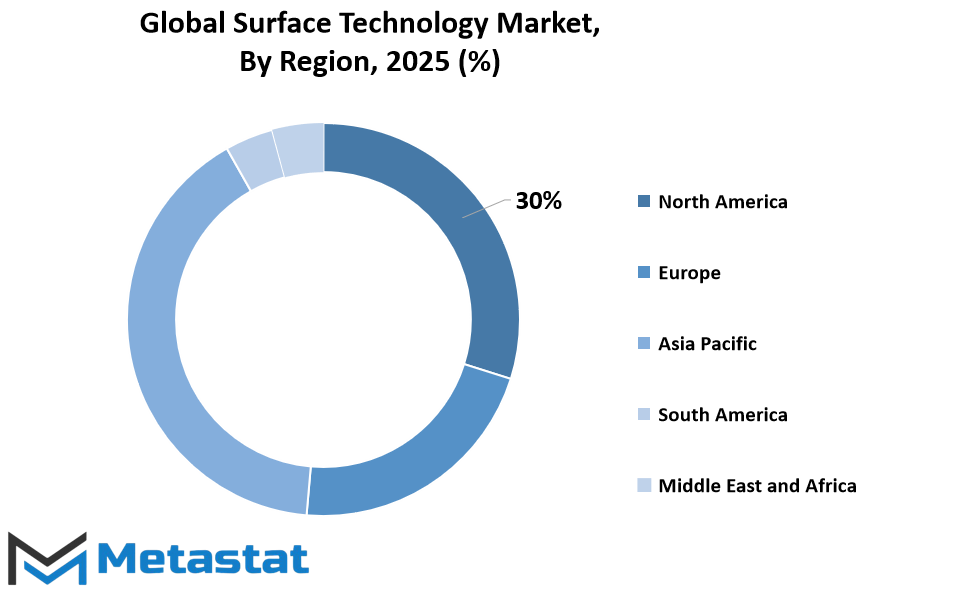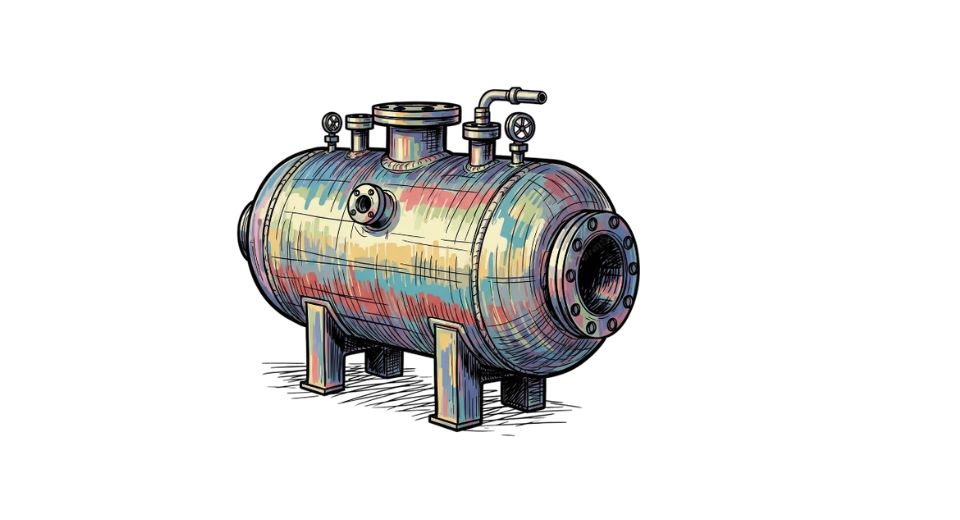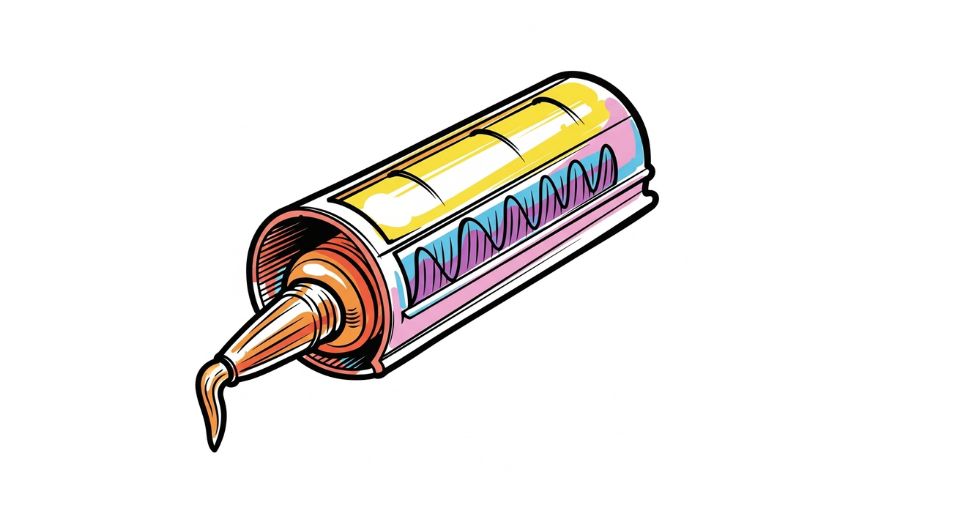MARKET OVERVIEW
The global surface technology market is at the intersection where innovation meets application, transcending traditional definitions of its sector. Over the next few years, it will not only serve to enhance coatings or surface properties; it will redefine materials' behavior and interaction with their surroundings. From enhanced wear resistance to functional beauty, the way this market is heading has the potential to revolutionize long-standing processes of manufacturing, building, transportation, and electronics. Though already, existing methods are very efficient, in the future, it will push the boundaries even further by infusing surfaces with intelligence and sustainability.
Not an improvement in performance but a shift in purpose is what the future holds. Surfaces will no longer be regarded as inert films but as active, functional interfaces that interact with external stimuli. As smart materials and nanostructures define the future of surface modification, the global surface technology market will create surfaces that respond to temperature, are resistant to biofouling, or even heal themselves upon damage. These capabilities, previously limited to scientific predictions, are now turning into commercial possibilities and will further evolve in the coming decade.
The manufacturing industry will soon find surfaces that proactively improve process efficiency by minimizing energy loss and maintenance cycles. Aerospace and car industries, constantly driven to maximize performance and minimize weight, will gain from newer coatings that provide both strength and lower friction without sacrificing safety. In architecture, buildings will employ surface technologies that not only defend against inclement weather but also clean air, inhibit microbial growth, and make energy more efficient through solar-reflective surfaces. All of this implies that the surface itself will be an active component of functional design, rather than a barrier or finish.
Very much supported by digitalization and automation, this change will reshape what is possible. Artificial intelligence and machine learning will be employed for the simulation and prediction of the behavior of surface treatments under varied conditions. It will result in quick prototyping and customization of solutions according to end-use specifications. Further, as customization becomes easier, surface technologies will start to tie up closely with user-centric design in consumer electronics as well as biomedical instruments. These uses will depend on biocompatible, wear-resistant surfaces and ones that can give feedback extending the applicability of surface technology into human-device integration.
Environmental considerations will also drive the global surface technology market outside of conventional practice. Tough global regulations for waste, emissions, and resource consumption will demand clean, safe, and recyclable surface technologies. Rather than depending on legacy coating systems that contain toxic chemicals or non-renewable materials, future technology will come from green chemistry and low-energy processes. As consumers become more aware, industries will be compelled to highlight not only functionality, but responsibility in how products are handled and maintained.
The global surface technology market, thus, will not only enable current infrastructure or product performance it will be a vehicle of transformation in the way we construct, move, connect, and inhabit. Through this development, consumers and industries alike will engage with surfaces anew and in meaningful ways that were not before imaginable.
Global surface technology market is estimated to reach $51,569.09 Million by 2032; growing at a CAGR of 5.0% from 2025 to 2032.

GROWTH FACTORS
The global surface technology market is gaining momentum due to its essential function in improving the performance, sturdiness, and visible appeal of materials hired in severa industries. As the need for longer-lasting and more long lasting products will increase, groups are the use of surface technology to provide solutions that can make it manifest. One of the most powerful drivers in the back of this marketplace is the call for for stepped forward corrosion resistance and preferred durability in business elements. Under harsh conditions of operation, untreated surfaces are much more likely to become worse at a quicker price, main to accelerated fees and downtime. Surface remedies improve components by way of including protecting coatings that lengthen their lifespan and simplify renovation.
A second key reason for the growth of the global surface technology market is the extensive application of surface technology within the automotive and aerospace industries. Both industries are dependent on precision and performance, and surface treatments contribute towards these measures. Whether it is increasing friction control, withstanding heat, or keeping materials strong under pressure, surface technology is a central contributor. With expanding industries comes increased dependence on treatments that increase safety and the product lifespan.
Even with these encouraging advancements, there are certain challenges restraining the full potential of the global surface technology market. High initial expenses usually accompany advanced surface technologies. The installation of the equipment, recruitment of skilled workers, and maintenance costs can be costly, particularly for small and medium-sized enterprises. Financial constraints apart, there are environmental guidelines to don't forget. Some of the treatments based totally on chemical substances have been prohibited because of the effects they have got on the surroundings, and organizations have had to reconsider or redecorate their techniques. The regulations can postpone the progress or upload to the price of locating alternatives.
There are, however, sure obvious opportunities at the horizon. Among the most promising is going toward environmentally friendly and nanotechnology-primarily based healing procedures. These new strategies seek to offer the same or maybe superior protection yet be safer for workers and the environment. As era advances, those inexperienced solutions will possibly get hold of increasing hobby from end-customers and manufacturers alike. Another sector with exceptional promise is the use of floor era in renewable energy and electronics. With sun panels, wind generators, and electronics turning into more regularly occurring, there is more and more demand for coats and finishes that could shield those belongings from wear and tear, moisture, and temperature fluctuations.
In the future, the global surface technology market will keep growing as companies pursue higher-performing substances and greener techniques. Though there are nonetheless obstacles, the call for advancement and the extended call for in all sectors will continue to propel this market in the direction of similarly improvement.
MARKET SEGMENTATION
By Type
The global surface technology market has undergone significant transformations in recent decades, motivated by the growing demand for superior material protection and performance. Among diverse strategies employed in floor generation, High Velocity Oxygen Fuel (HVOF) coatings have come to be increasingly popular, with a market length of $5,962.87 million. The growth is attributed to the developing demand for tough and corrosion-resistant coatings in sectors including aerospace, automobile, and electricity. These industries are depending on effective surface treatment answers in order to prolong the life of device and decrease maintenance fees.
Plasma and ceramic coatings are also gaining traction. Their capability to offer excellent heat resistance and wear safety has made them a depended on desire in diverse applications. Anodizing stays a popular approach, specially for boosting the visible appeal and surface integrity of aluminum components. Vapor section aluminate, slurry coatings, and other kinds of remedies further enable the industry to fulfill its broad need, permitting producers to tailor surfaces based totally on the use, wearability, and environmental call for.
What makes the global surface technology market in particular interesting is its contribution to improving product life and overall performance in key industries. Along with advancing technology and elevated needs for materials, floor remedies will continue to be a major driver of innovation. This marketplace, with its range of coating solutions and technical alternatives, will continue to influence the manner industries defend and decorate the materials they depend on.
By End-use Industry
The global surface technology market is influenced by numerous industries, which apply surface treatments to improve the performance, longevity, and appearance of their products. With era having an ongoing impact on manufacturing norms, floor solutions have end up more essential than ever in diverse industries. In the car region, they may be implemented to decorate corrosion resistance, sell higher paint adhesion, and make additives final longer under harsh situations. Similarly, within the oil and fuel sector, wherein gadget is uncovered to intense environments, shielding coatings are vital to save you wear and amplify operational existence.
Both protection and performance in aerospace and defense rely considerably on sophisticated floor technologies. From treatment of engine components to shield sensitive instruments, the treatments contribute to strict regulatory compliance while cutting costs on maintenance. In medicine, surface technology is fundamental to guarantee that devices are biocompatible, sterile, and long-term safe. The treatments also improve accuracy, which is critical in instruments and implants.
Semiconductor and electronics producers enjoy surface technologies because they apply them to manage conductivity, avoid contamination, and ensure performance as devices get smaller. Even those industries that might not first spring to mind, such as those making equipment that doesn't fall into the big sectors, apply these solutions to satisfy customers and enhance product reliability.
While maritime and shipbuilding uses are a subset of the overall market, the concentration in this instance is on industries such as automotive, oil and gas, aerospace and defense, medical devices and healthcare, electronics and semiconductors, and others. Each has its own requirement, which continues to propel innovation and adjustment in how surface technology is used. The increased demand within these industries portends a future in which surface solutions will continue to be a behind-the-scenes but necessary component of manufacturing success.
|
Forecast Period |
2025-2032 |
|
Market Size in 2025 |
$36,694.53 million |
|
Market Size by 2032 |
$51,569.09 Million |
|
Growth Rate from 2025 to 2032 |
5.0% |
|
Base Year |
2024 |
|
Regions Covered |
North America, Europe, Asia-Pacific, South America, Middle East & Africa |
REGIONAL ANALYSIS
The global surface technology market is divided into various key regions, each contributing a distinct role towards the development and direction of the industry. These are North America, Europe, Asia-Pacific, South America, and Middle East & Africa. The market in North America is further divided into the United States, Canada, and Mexico. The U.S. is traditionally considered a hub country because of its technological and industrial requirements, and Canada and Mexico also contribute consistently in terms of manufacturing and trade relationships.
On the European continent, the global surface technology market is divided into the United Kingdom, Germany, France, Italy, and the balance of Europe. Germany is famous for their precision engineering that drives the demand for surface technology in industries such as machinery and automobiles. On the other hand, the UK, France, and Italy offer innovation, improvement of consumer merchandise, and export-oriented manufacturing that makes the demand for floor remedy techniques sturdy throughout all industries.
Asia-Pacific regions include India, China, Japan, South Korea, and the the rest of Asia-Pacific. The international is experiencing a speedy business boom in this vicinity, with India and China dominating high-extent production, infrastructure development, and expanding client markets. Japan and South Korea additionally make big contributions via electronics, automobile, and excessive-technology business device, in which quality surface completing performs a determinant function in product performance and sturdiness.
In South America, Brazil and Argentina are the primary contributors, but the rest of the continent also plays its part in the global surface technology market. Brazil's developing manufacturing sector and construction industry contribute a consistent demand for surface solutions. Argentina and the rest of the nations in this region are constantly looking for means to modernize their industries, which contributes to the market presence incrementally.
The Middle East & Africa market is broken down into GCC Countries, Egypt, South Africa, and the remaining Middle East & Africa. GCC countries have been spending on new energy and infrastructure projects, which tend to call for tough, corrosion-resistant materials something surface technology can provide. Egypt and South Africa also demonstrate increasing promise, bolstered by advancements in urban building, transport, and resource-based industries.
Each of these areas has a unique role in the overall global ecosystem, with each providing both challenges and opportunities for those businesses seeking to increase their footprint in the market for surface technology. As global demand continues to move with industrial and technological development, regional specifics will dictate the manner and extent in which companies elect to do business.

COMPETITIVE PLAYERS
The global surface technology market is increasingly forming the basis of contemporary manufacturing. As industries require better sturdiness, stepped forward wear resistance, and sophisticated coating programs, floor technology maintains gaining prominence. From aviation to automobile and electronics, organizations are looking for approach to decorate the lifespan in their additives and improve performance in traumatic situations. As extra is sought for sustainable and electricity-saving alternatives, this marketplace not just evolves it steps as much as the plate.
Surface generation encompasses a range of methods that beautify or regulate the floor of materials to cause them to extra proof against corrosion, friction, and severe temperatures. These strategies are more and more being embraced at an accelerating charge with the aid of a wide variety of industries that rely substantially on precision and reliability over the long time. In cutting-edge fiercely aggressive production surroundings, owning better floor traits is now not a luxury it's a necessity. The businesses are making an investment in those technologies so that their products remain superior in fine and overall performance.
This has created a lot of established industry players. Aalberts Surface Technology, APS Materials Inc., OC Oerlikon Balzers, and ASM Pacific Technology are some of the active players in this field. Each of them brings its own techniques and innovations and facilitates the market's consistent development. Bodycote plc and Dürr AG have also gained a reputation for their dedicated work in establishing high-performance treatments. Schaeffler Group, FPM Heat Treating, and Fuji Machine Manufacturing Co., Ltd. are among the other companies pushing the limits with specialized solutions in line with particular industries.
New technologies and increasing applications have introduced names such as Fusor Technologies and Guangdong Strong Metal Technology Co. Ltd., who are making a perceptible presence. At the same time, Harterei Reese, Kermetico Inc., and Linde Plc are introducing their own heritage of innovation. Mycronic, Neoden SMT, and Nordson Corporation are making it happen through technological innovation in electronic production and precision coating. Oerlikon Metco and Surface Technology, Inc. are leading the way with their niche expertise, while Parker Trutec Group, Saint-Gobain, and Surface Solution are reinforcing the global surface technology market.
The future will predictably witness an increase in demand for affordable, sustainable coating processes. With industries remaining underneath strain to reduce emissions and waste material, floor technologies have to help them reap their desires. Smart production strategies and automation will even form how these technology are carried out, streamlining techniques and making them extra managed. With the introduction of new substances into production strains, the call for for flexible and like minded surface treatments will further upward push.
In the quit, the global surface technology market will take center level in guiding industries to remember performance, safety, and sustainability. It is driven by using utilitarian wishes and supported via ongoing innovation. As groups keep to demand more from products and what they could deliver, the market will continue to grow in importance quietly, efficiently, and regularly changing the world's manufacturing strategies.
Surface Technology Market Key Segments:
By Type
- High Velocity Oxygen Fuel (HVOF) Coatings
- Plasma
- Ceramic Coatings
- Anodizing
- Vapor Phase Aluminate
- Slurry Coatings
- Other
By End-use Industry
- Automotive
- Oil and Gas
- Aerospace and Defense
- Medical Devices and Healthcare
- Electronics and Semiconductors
- Marine and Shipbuilding
- Other
Key Global Surface Technology Industry Players
- Aalberts Surface technology
- APS Materials Inc.
- OC Oerlikon Balzers
- ASM Pacific Technology
- Bodycote plc
- Dürr AG
- Schaeffler Group
- FPM Heat Treating
- Fuji Machine Manufacturing Co., Ltd.
- Fusor Technologies
- Guangdong Strong Metal Technology Co.Ltd,
- Harterei Reese
- Kermetico Inc.
- Linde Plc
- Mycronic
- Neoden SMT
- Nordson Corporation
- Oerlikon Metco
- Surface Technology, Inc.
- Parker Trutec Group
- Saint-Gobain Surface Solution
WHAT REPORT PROVIDES
- Full in-depth analysis of the parent Industry
- Important changes in market and its dynamics
- Segmentation details of the market
- Former, on-going, and projected market analysis in terms of volume and value
- Assessment of niche industry developments
- Market share analysis
- Key strategies of major players
- Emerging segments and regional growth potential








 US: +1 3023308252
US: +1 3023308252






